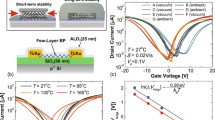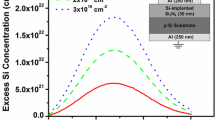Abstract
Silicon nanocrystals have made a recent appearance in the literature because of their potential importance in microelectronic[1] and optoelectronic [2] devices. For example, replacing the traditional Si floating gate in nonvolatile memory field effect transistors with nanocrystals has been shown to produce more reliable and lower power memory devices than traditional transistors [1]. Controlled oxidation of Si nanocrystals is desirable in the processing of Si quantum dots for these devices. If controlled oxidation is attainable, then it could be used to control nanocrystal size, achieve high nanocrystal density, and achieve a high quality interface between Si dot and SiO2 gate oxide layer in nanocrystal based memory. In this work, we report the oxidation properties of various sized silicon nanocrystals, deposited by low-pressure chemical vapor deposition, in different oxidizing environments. In the literature, when a Si column or dot is oxidized below the viscoelastic temperature of SiO2 (950 oC), the oxidation will self-limit to a Si core size that is dependent on the oxidizing conditions and the initial particle size. This self-limiting phenomenon is said to occur because of the presence of a compressive stress in the oxide layer that limits the diffusion of the oxidizing agent through the SiO2 to the Si- SiO2 interface. This compressive stress is present at the interface because of the difference in the density of the oxide and the Si and is enhanced by the radius of curvature of the dot. This self- limiting oxidation phenomenon will be studied experimentally using microscopy techniques and the effect of the constrained structure will be characterized.
Similar content being viewed by others
References
S. Tiwari, F. Rana, H. Hanafi, A. Hartstein, E.F. Crabbé, and Kevin Chan, Appl. Phys. Lett., 68, 1377 (1996).
A.G. Nassiopoulos and S. Grigoropoulos, Appl. Phys. Lett., 69, 2267 (1996).
M.L. Brongersma, A. Polman, K.S. Min, E. Boer, T. Tambo, and H.A. Atwater, Appl. Phys. Lett., 72, 2577 (1998).
B.E. Deal and A.S. Grove, J. Appl. Phys., 36, 3770 (1965).
D.-B Kao, J.P. McVittie, W.D. Nix, K.C. Saraswat, IEEE Transactions on Electron Devices, ED-34, 1008 (1987)
D.-B Kao, J.P. McVittie, W.D. Nix, K.C. Saraswat, IEEE Transactions on Electron Devices, ED-35, 25 (1998).
H. Fukuda, N. Koyama, T. Endoh, and S. Nomura, Appl. Surf. Sci., 113/114, 595 (1997).
C. Single, F. Zhou, H. Heidemeyer, F.E. Prins, D.P. Kern, and E. Plies, J. Vac. Sci. Technol. B, 16, 3938 (1998).
Author information
Authors and Affiliations
Rights and permissions
About this article
Cite this article
Scheer, K.C., Madhukar, S., Muralidar, R. et al. Oxidation of Silicon Nanocrystals. MRS Online Proceedings Library 638, 631 (2000). https://doi.org/10.1557/PROC-638-F6.3.1
Published:
DOI: https://doi.org/10.1557/PROC-638-F6.3.1




